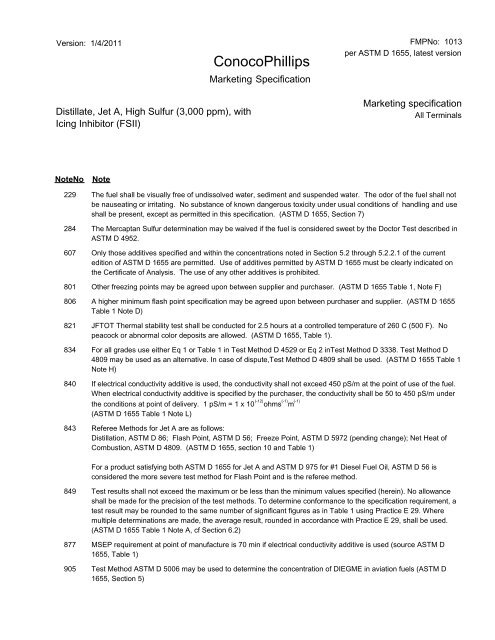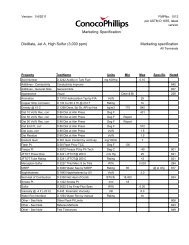Jet A with PFA 56 MB - Phillips 66 Aviation
Jet A with PFA 56 MB - Phillips 66 Aviation
Jet A with PFA 56 MB - Phillips 66 Aviation
You also want an ePaper? Increase the reach of your titles
YUMPU automatically turns print PDFs into web optimized ePapers that Google loves.
FMPNo: 1013<br />
per ASTM D 1655, latest version<br />
Marketing<br />
Specification<br />
Distillate, <strong>Jet</strong> A, High Sulfur (3,000 ppm), <strong>with</strong><br />
Icing Inhibitor (FSII)<br />
Marketing specification<br />
All Terminals<br />
NoteNo<br />
Note<br />
229 The fuel shall be visually free of undissolved water, sediment and suspended water. The odor of the fuel shall not<br />
be nauseating or irritating. No substance of known dangerous toxicity under usual conditions of handling and use<br />
shall be present, except as permitted in this specification. (ASTM D 1655, Section 7)<br />
284 The Mercaptan Sulfur determination may be waived if the fuel is considered sweet by the Doctor Test described in<br />
ASTM D 4952.<br />
607 Only those additives specified and <strong>with</strong>in the concentrations noted in Section 5.2 through 5.2.2.1 of the current<br />
edition of ASTM D 1655 are permitted. Use of additives permitted by ASTM D 1655 must be clearly indicated on<br />
the Certificate of Analysis. The use of any other additives is prohibited.<br />
801 Other freezing points may be agreed upon between supplier and purchaser. (ASTM D 1655 Table 1, Note F)<br />
806 A higher minimum flash point specification may be agreed upon between purchaser and supplier. (ASTM D 1655<br />
Table 1 Note D)<br />
821 JFTOT Thermal stability test shall be conducted for 2.5 hours at a controlled temperature of 260 C (500 F). No<br />
peacock or abnormal color deposits are allowed. (ASTM D 1655, Table 1).<br />
834 For all grades use either Eq 1 or Table 1 in Test Method D 4529 or Eq 2 inTest Method D 3338. Test Method D<br />
4809 may be used as an alternative. In case of dispute,Test Method D 4809 shall be used. (ASTM D 1655 Table 1<br />
Note H)<br />
840 If electrical conductivity additive is used, the conductivity shall not exceed 450 pS/m at the point of use of the fuel.<br />
When electrical conductivity additive is specified by the purchaser, the conductivity shall be 50 to 450 pS/m under<br />
the conditions at point of delivery. 1 pS/m = 1 x 10 (-12) ohms (-1) m (-1)<br />
(ASTM D 1655 Table 1 Note L)<br />
843 Referee Methods for <strong>Jet</strong> A are as follows:<br />
Distillation, ASTM D 86; Flash Point, ASTM D <strong>56</strong>; Freeze Point, ASTM D 5972 (pending change); Net Heat of<br />
Combustion, ASTM D 4809. (ASTM D 1655, section 10 and Table 1)<br />
For a product satisfying both ASTM D 1655 for <strong>Jet</strong> A and ASTM D 975 for #1 Diesel Fuel Oil, ASTM D <strong>56</strong> is<br />
considered the more severe test method for Flash Point and is the referee method.<br />
849 Test results shall not exceed the maximum or be less than the minimum values specified (herein). No allowance<br />
shall be made for the precision of the test methods. To determine conformance to the specification requirement, a<br />
test result may be rounded to the same number of significant figures as in Table 1 using Practice E 29. Where<br />
multiple determinations are made, the average result, rounded in accordance <strong>with</strong> Practice E 29, shall be used.<br />
(ASTM D 1655 Table 1 Note A, cf Section 6.2)<br />
877 MSEP requirement at point of manufacture is 70 min if electrical conductivity additive is used (source ASTM D<br />
1655, Table 1)<br />
905 Test Method ASTM D 5006 may be used to determine the concentration of DIEGME in aviation fuels (ASTM D<br />
1655, Section 5)




